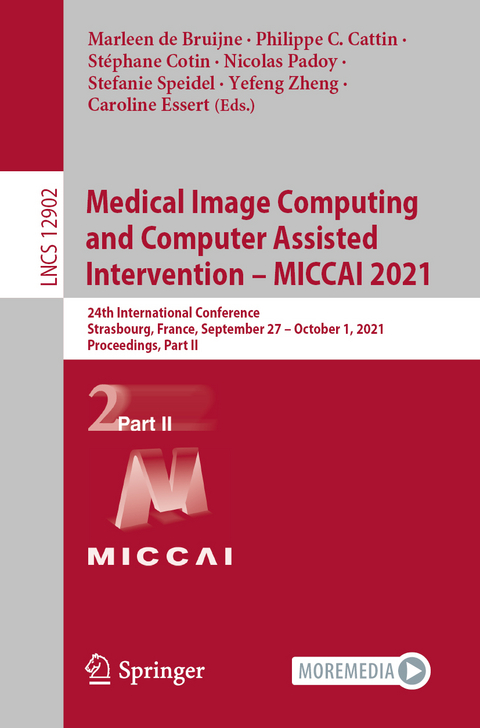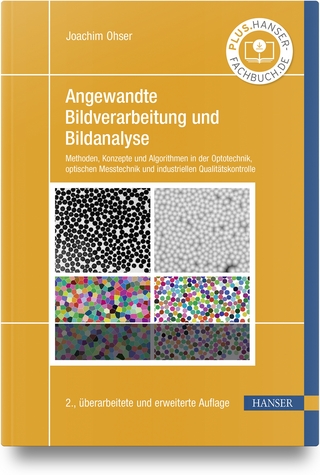
Medical Image Computing and Computer Assisted Intervention – MICCAI 2021
Springer International Publishing (Verlag)
978-3-030-87195-6 (ISBN)
The 531 revised full papers presented were carefully reviewed and selected from 1630 submissions in a double-blind review process. The papers are organized in the following topical sections:
Part I: image segmentation
Part II: machine learning - self-supervised learning; machine learning - semi-supervised learning; and machine learning - weakly supervised learning
Part III: machine learning - advances in machine learning theory; machine learning - attention models; machine learning - domain adaptation; machine learning - federated learning; machine learning - interpretability / explainability; and machine learning - uncertainty
Part IV: image registration; image-guided interventions and surgery; surgical data science; surgical planning and simulation; surgical skill and work flow analysis; and surgical visualization and mixed, augmented and virtual reality
Part V: computer aided diagnosis; integration of imaging with non-imaging biomarkers; and outcome/disease prediction
Part VI: image reconstruction; clinical applications - cardiac; and clinical applications - vascular
Part VII: clinical applications - abdomen; clinical applications - breast; clinical applications - dermatology; clinical applications - fetal imaging; clinical applications - lung; clinical applications - neuroimaging - brain development; clinical applications - neuroimaging - DWI and tractography; clinical applications - neuroimaging - functional brain networks; clinical applications - neuroimaging - others; and clinical applications - oncology
Part VIII: clinical applications - ophthalmology; computational (integrative) pathology; modalities - microscopy; modalities - histopathology; and modalities - ultrasound
*The conference was held virtually.
Machine Learning - Self-Supervised Learning.- SSLP: Spatial Guided Self-supervised Learning on Pathological Images.- Segmentation of Left Atrial MR Images via Self-supervised Semi-supervised Meta-learning.- Deformed2Self: Self-Supervised Denoising for Dynamic Medical Imaging.- Imbalance-Aware Self-Supervised Learning for 3D Radiomic Representations.- Self-supervised visual representation learning for histopathological images.- Contrastive Learning with Continuous Proxy Meta-Data For 3D MRI Classification.- Sli2Vol: Annotate a 3D Volume from a Single Slice with Self-Supervised Learning.- Self-Supervised Longitudinal Neighbourhood Embedding.- Self-Supervised Multi-Modal Alignment For Whole Body Medical Imaging.- SimTriplet: Simple Triplet Representation Learning with a Single GPU.- Lesion-based Contrastive Learning for Diabetic Retinopathy Grading from Fundus Images.- SAR: Scale-Aware Restoration Learning for 3D Tumor Segmentation.- Self-Supervised Correction Learning for Semi-Supervised Biomedical Image Segmentation.- SpineGEM: A Hybrid-Supervised Model Generation Strategy Enabling Accurate Spine Disease Classification with a Small Training Dataset.- Contrastive Learning of Relative Position Regression for One-Shot Object Localization in 3D Medical Images.- Topological Learning and Its Application to Multimodal Brain Network Integration.- One-Shot Medical Landmark Detection.- Implicit field learning for unsupervised anomaly detection in medical images.- Dual-Consistency Semi-Supervised Learning with Uncertainty Quantification for COVID-19 Lesion Segmentation from CT Images.- Contrastive Pre-training and Representation Distillation for Medical Visual Question Answering Based on Radiology Images.- Positional Contrastive Learning for Volumetric Medical Image Segmentation.- Longitudinal self-supervision to disentangle inter-patient variability from disease progression.- Self-Supervised Vessel Enhancement Using Flow-Based Consistencies.- Unsupervised Contrastive Learning of Radiomics and Deep Features for Label-Efficient Tumor Classification.- Learning 4D Infant Cortical Surface Atlas with Unsupervised Spherical Networks.- Multimodal Representation Learning via Maximization of Local Mutual Information.- Inter-Regional High-level Relation Learning from Functional Connectivity via Self-Supervision.- Machine Learning - Semi-Supervised Learning.- Semi-supervised Left Atrium Segmentation with Mutual Consistency Training.- Semi-supervised Meta-learning with Disentanglement for Domain-generalised Medical Image Segmentation.- Efficient Semi-Supervised Gross Target Volume of Nasopharyngeal Carcinoma Segmentation via Uncertainty Rectified Pyramid Consistency.- Few-Shot Domain Adaptation with Polymorphic Transformers.- Lesion Segmentation and RECIST Diameter Prediction via Click-driven Attention and Dual-path Connection.- Reciprocal Learning for Semi-supervised Segmentation.- Disentangled Sequential Graph Autoencoder for Preclinical Alzheimer's Disease Characterizations from ADNI Study.- POPCORN: Progressive Pseudo-labeling with Consistency Regularization and Neighboring.- 3D Semantic Mapping from Arthroscopy using Out-of-distribution Pose and Depth and In-distribution Segmentation Training.- Semi-Supervised Unpaired Multi-Modal Learning for Label-Efficient Medical Image Segmentation.- Implicit Neural Distance Representation for Unsupervised and Supervised Classification of Complex Anatomies.- 3D Graph-S2Net: Shape-Aware Self-Ensembling Network for Semi-Supervised Segmentation with Bilateral Graph Convolution.- Duo-SegNet: Adversarial Dual-Views for Semi-Supervised Medical Image Segmentation.- Neighbor Matching for Semi-supervised Learning.- Tripled-uncertainty Guided Mean Teacher model for Semi-supervised Medical Image Segmentation.- Learning with Noise: Mask-guided Attention Model for Weakly Supervised Nuclei Segmentation.- Order-Guided Disentangled Representation Learning for Ulcerative Colitis Classification with Limited Labels.- Semi-supervised Contrastive Learning for Label-efficient Medical Image Segmentation.- Functional Magnetic Resonance Imaging data augmentation through conditional ICA.- Scalable joint detection and segmentation of surgical instruments with weak supervision.- Machine Learning - Weakly Supervised Learning.- Weakly-Supervised Universal Lesion Segmentation with Regional Level Set Loss.- Bounding Box Tightness Prior for Weakly Supervised Image Segmentation.- OXnet: Deep Omni-supervised Thoracic Disease Detection from Chest X-rays.- Adapting Off-the-Shelf Source Segmenter for Target Medical Image Segmentation.- Quality-Aware Memory Network for Interactive Volumetric Image Segmentation.- Improving Pneumonia Localization via Cross-Attention on Medical Images and Reports.- Combining Attention-based Multiple Instance Learning and Gaussian Processes for CT Hemorrhage Detection.- CPNet: Cycle Prototype Network for Weakly-supervised 3D Renal Chamber Segmentation.- Observational Supervision for Medical Image Classification using Gaze Data.- Inter Extreme Points Geodesics for End-to-End Weakly Supervised Image Segmentation.- Efficient and Generic Interactive Segmentation Framework to Correct Mispredictions during Clinical Evaluation of Medical Images.- Learning Whole-Slide Segmentation from Inexact and Incomplete Labels using Tissue Graphs.- Labels-set Loss Functions for Partial Supervision: Application to Fetal Brain 3D MRI Parcellation.
| Erscheinungsdatum | 25.09.2021 |
|---|---|
| Reihe/Serie | Image Processing, Computer Vision, Pattern Recognition, and Graphics | Lecture Notes in Computer Science |
| Zusatzinfo | XXXVII, 662 p. 181 illus., 175 illus. in color. |
| Verlagsort | Cham |
| Sprache | englisch |
| Maße | 155 x 235 mm |
| Gewicht | 1056 g |
| Themenwelt | Informatik ► Grafik / Design ► Digitale Bildverarbeitung |
| Informatik ► Theorie / Studium ► Künstliche Intelligenz / Robotik | |
| Schlagworte | Applications • Artificial Intelligence • Bioinformatics • Computer Aided Diagnosis • computer assisted interventions • Computer Science • computer vision • conference proceedings • Data Mining • Image Analysis • image matching • Image Processing • Image Quality • image reconstruction • Image Segmentation • Imaging Systems • Informatics • machine learning • Medical Images • Neural networks • Object recognition • pattern recognition • Research • segmentation methods |
| ISBN-10 | 3-030-87195-9 / 3030871959 |
| ISBN-13 | 978-3-030-87195-6 / 9783030871956 |
| Zustand | Neuware |
| Haben Sie eine Frage zum Produkt? |
aus dem Bereich


